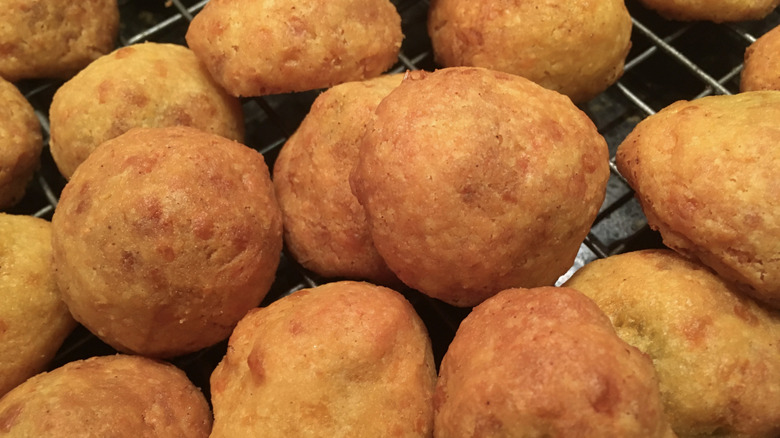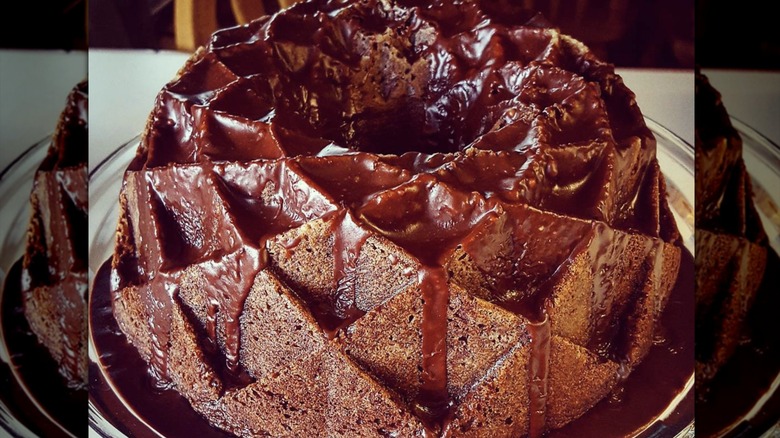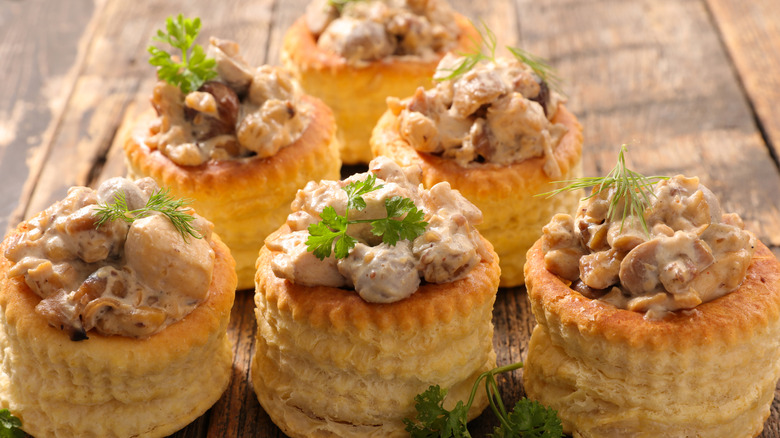These Old-Fashioned Christmas Foods Are Worthy Of A Comeback
Making sure your holiday gathering goes off without a hitch requires planning and coordination. With all the moving parts involved, it's easy to default to a basic menu that leaves your guests satiated, and generally underwhelmed. There's nothing wrong with a cookie cutter Christmas spread, in the same way that most people don't hate eating turkey dinner weeks after Thanksgiving. What if we told you your table could be different this year? By bringing back holiday foods that were popular long ago, you'll actually wind up with a festive menu that feels fresher than the rest.
At one time or another, the foods on this list had a major Christmas moment. Some have been forgotten by time, while others are regional holiday specialties or niche family traditions. We embrace old-fashioned holiday flavors by making eggnog or gingerbread people, so why not give some lesser-known festive fare a try? For inspiration, take a look at the foods we've rounded up here. They run the gamut from mid-century trends to olden Christmas customs, and all of them are due for a comeback.
Bûche de Noël (aka Yule Log)
No cake smacks of Christmas like bûche de Noël — better known in the states as a yule log. Long before the bûche's heyday in the pâtisseries of Paris, French people (and other Europeans) lit an actual yule log on Christmas Eve and kept it burning until the Twelfth Night (aka Epiphany Eve). Christians embraced this practice, but for hundreds of years, yule logs were part of pagan fire festivals celebrating the winter solstice.
As the modern world chugged along, lighting yule logs became less mainstream. The French honored the log's legacy by making a version out of cake, called bûche de Noël. One of the earliest documented recipes appeared in Pierre Lacam's 1890 book, "Le Mémorial Historique et Géographique de la Pâtisserie." It called for rounds of génoise sponge and coffee or chocolate buttercream layered together to form a log. Smaller génoise rounds were affixed to the log with buttercream to mimick branches. A final buttercream coating was piped from a fluted nozzle to evoke a bark-like texture.
Lacam later credited Antoine Charabot with creating the original bûche de Noël in 1879. Additions like chopped pistachios and meringue mushrooms helped create the bûche's "fresh from the forest" look. Tons of variations have been dreamed up since the 19th century. Want to bring back the yule log this Christmas? Check out our recipe here.
Pineapple casserole
If you're sitting there thinking about all the reasons why pineapple casserole couldn't (or shouldn't) work, rest your skepticism aside and hear us out. Pineapple casserole is one of the I.Y.K.Y.K. dishes of Southern cuisine and is largely thought of as a special occasion food. In the 1950s, casserole-making had reached a fever pitch in home kitchens. Suddenly, it became okay to combine pantry items that didn't really go together as long as they were inside a casserole dish, covered with cracker crumbs, and served with a smile. Pineapple casserole is a likely manifestation of this culinary ethos, but in this case, it's weird enough to work.
Cans of crushed pineapple and pineapple chunks combined with sugar, melted butter, flour, shredded cheddar cheese, and crumbled Ritz crackers are pineapple casserole's main ingredients. The amalgamation creates a sweet, savory, comforting dish that's right at home for the holidays. The pineapple casseroles that wind up on modern Christmas tables are usually there because someone's auntie or grandma loves making it for old time's sake. Today's foodies might be inclined to balk at the casserole's ingredients list, mostly comprised of canned and processed foods.
We're not saying pineapple casserole should be a regular part of your diet, but for a holiday celebration, we say bring it on. Besides, this fruity casserole is a great companion to Christmas ham. Give this Southern specialty a try with Mashed's old-fashioned pineapple casserole recipe.
Peking duck
The words "Peking duck" and "Christmas" were inextricably linked after a scene from the 1983 film "A Christmas Story" depicted Ralphie and fam enjoying the water fowl for their holiday at Chop Suey Palace. The scene plays into more than a few Chinese-American stereotypes, which speaks to what little knowledge the general public had about Peking duck and its deep roots in Eastern culture. The film's success made Christmas feasts of Peking duck an ongoing trend, but the Beijing-born dish has been a celebratory meal since at least the 1200s.
As early as the Yuan Dynasty, beginning in 1271, Peking duck was eaten by members of the imperial court. It remained an exclusive food amongst the upper classes until the 18th century, when it was served in restaurants. By the 1800s, Peking duck had gained traction in the West, yet over time, its presence in the U.S. grew more niche — hence the renewed curiosity after "A Christmas Story" was released.
Preparing Peking duck in the traditional style requires marinating the bird in soy sauce, rice wine, and Chinese five-spice, then roasting in a closed oven. This method cultivates the crispy skin and tender meat Peking duck is known for. It is served sliced, alongside Chinese sides and condiments like scallion pancakes and hoisin sauce. Reviving this showstopper at your holiday party will no doubt be a hit (here's our at-home Peking duck recipe), just be sure to pair some Asian-inspired dishes and sauces with it.
Oyster stew
Clam chowder is a U.S. mainstay, especially during the chilly winter months, but oyster stew also had a foothold on Christmas menus of yesteryear. One region keeping oyster stew alive during the holidays is the Midwest. In these parts, eating oyster stew on Christmas Eve has been a tradition since the mid-1800s.
Midwestern-style oyster stew keeps it simple. The oysters are gently poached in milk and butter then seasoned with black pepper. Irish immigrants popularized Christmas Eve oyster stew, and their motivations for doing so were religion-based. Catholics do not eat meat on the eve of religious holidays, so the Irish opted for stew with salted and dried fish. When European colonists made landfall on the East Coast in the 1600s, they learned many culinary practices from indigenous Americans. The natives introduced the settlers to oysters, which were abundant in coastal waters.
Oyster stew eventually made its way to the Midwest. Hauls of oysters arriving inland traditionally marked the start of the winter holiday season. The briny, creamy soup isn't as prevalent as it was in earlier centuries, but that should change. A dash of Worcestershire sauce, a few shakes of paprika, and a sprinkle of herbs are great ways to enliven oyster stew for your Christmas shindig. Don't forget the oyster crackers.
Beef Wellington
Hoping to wow your inner circle with your culinary prowess this Christmas? Beef Wellington is a fabulous choice for smaller holiday get-togethers because while it won't feed a large crowd, it's sure to make an impact. Beef Wellington is an old-timey delight in the best of ways. The dish was created to honor Britain's First Duke of Wellington, Arthur Wellesley, after he and his fellow Brits clinched victory against Napoleon at the Battle of Waterloo in 1815.
Wrapping a center-cut beef tenderloin in puff pastry (a signature starch in French recipes of the day), gives Beef Wellington more sophistication than a typical English meat pie. In the 1960s, Beef Wellington had a big moment in America. Julia Child was a fan; she published a Beef Wellington recipe in her landmark 1961 cookbook "Mastering the Art of French Cooking" and cooked it on her PBS show in 1965. Classy Beef Wellington was also adored by Presidents Kennedy and Nixon.
Crafting a Beef Wellington of your own is a little time-consuming, but your efforts won't be in vain. Searing beef and sautéing duxelles are part of the process, as is wrapping both up in a puff pastry and baking it to a perfect golden brown. Consider Mashed's recipe for Beef Wellington with a twist, which calls for individual Wellington portions.
Sherbet punch
If you attended holiday parties in the '80s or '90s, chances are you've been face-to-face with a punch bowl full of sherbet, orange slices, and maraschino cherries. Sherbet has been in the culinary lexicon since 11th-century Persia, as a sorbet-like beverage. It maintained widespread popularity, especially in mid-century America, when brands like Baskin-Robbins and Dairy Queen sold their own versions. Tri-color sherbet was invented in Pennsylvania in the 1950s.
Baskin-Robbins jumped on the multi-hued trend, selling Rainbow sherbet and Wild 'n Reckless sherbet. Each variety combined a trio of colors and flavors including blue raspberry, fruit punch and green apple. Fruit punch was exactly where sherbet landed. Lemon-lime soda purveyor 7-Up has advertised sherbet punch recipes for more than 60 years, including a Christmas version called "7-Up Evergreen Bowl" that called for 12 seven-ounce bottles of 7-Up and four pints of lime sherbet.
Pouring lemon-lime soda or ginger ale over slightly thawed sherbet sends a fizzy, creamy foam floating to the top of the punch bowl. It's a perfect backdrop for mixed fruit — a combination of fresh citrus, jarred cherries, and frozen berries gives sherbet punch a charming vintage vibe. Sherbet punch recipes are easy to modify. You can combine equal parts soda and juice or use any flavor of sherbet you like. Care for some spiked punch? Champagne or Prosecco are great picks because they add to the fizz.
Roasted goose
Interested in serving something really olde world this Christmas? Try swapping out the usual turkey or ham in favor of roast goose. Roasting a goose for festive occasions is a practice that dates back to Ancient Greece and Rome. In medieval Europe, goose was the preferred centerpiece of Christmas dinners, and the custom continued into the Victorian era.
For centuries, geese were common farm animals whose foraging behaviors helped farmers in more ways than one. During harvesting season, farmers let geese loose in the fields to gobble up the loose grain leftover from the crops being reaped. This not only prevented farmed food from going to waste, it fattened the geese up. When the time came to prepare a bird for the holiday feast, a fattened goose made for more succulent meat.
Colonists settling in North America, found a plentiful food source in Canada geese — at first. As time went on, habitual overhunting of geese caused a significant decline in the species' population. Under the Migratory Bird Treaty Act of 1918, hunting migratory birds requires a federal permit. Today, geese that are sold for consumption are farm-raised. Goose meat is darker than turkey meat, and the roasting process will render more fat. To wind up with a less oily bird, you can poach the goose prior to roasting.
Pfeffernüsse cookies
Bring a taste of the unexpected to this season's cookie swap with pfeffernüsse. German for "pepper-nut", pfeffernüsse cookies are robustly spiced, petite, gingerbread covered in icing or powdered sugar. What sets pfeffernüsse cookies apart from more conventional Christmas cookies is the inclusion of an unusual ingredient: black pepper.
The black pepper taste in a pfeffernüsse cookie is subtle. Depending on the recipe you use, anywhere between one and two dozen different spices are called for. Cinnamon, ginger, and clove will almost certainly be among them. Coriander, allspice, and cardamom are often featured as well. The spice blend, plus sweetness from molasses or honey give pfeffernüsse cookies a more nuanced flavor than the average gingerbread. Icing or rolling them in powdered sugar keeps the zing from being too intense.
By most accounts, the original pfeffernüsse cookie was developed by German confectioner, John Fleischmann in 1753. When German Mennonites immigrated to America in the early 1800s, they brought the pfeffernüsse cookie recipe with them. By the 1850s, pfeffernüsse cookies' association with Christmas had caught on in several nations.
Olive cheese puffs
Take it back to the 1950s, with an hors d'oeuvre that marries olives and cheese in one adorable little puff. Back in the days when it was primarily a housewife's responsibility to entertain in the home, some pretty inventive stuff landed on the business end of toothpicks. Olive cheese puffs are one such invention, and they're a perfect bite for the holiday party cocktail hour.
Balls of cheddar cheese dough wrapped around pimento-stuffed Spanish green olives are the kind of warm cocktail appetizer we should see more of at Christmas soirées. The olive's brininess is a great compliment to the rich cheddar puff. Like any recipe that's been around long enough, there are deviations to how olive cheese puffs can be made.
For instance, adding an egg in the cheese puff dough is known to create a better dough consistency. You can also use the olive type of your choice, but most recipes suggest the pimento-stuffed Spanish variety. Even Old Hollywood actress Claudette Colbert had her own olive cheese puff recipe — it incorporated Tabasco sauce for a little extra kick.
Chocolate Kahlúa cake
Bundt cakes carry an old-school reputation, but that doesn't mean some retro Bundts weren't downright delicious. One standout is chocolate Kahlúa cake. This rich confection smacks of chocolatey goodness and is beautifully accented with notes of coffee and rum — courtesy of legendary Mexican liqueur, Kahlúa. Bundt cake is the descendent of centuries-old, Central European cakes known as kugelhopfs or gugelhupfs. Kugelhopfs were tall with a hole in the middle and made from a yeasted dough. Even back then, kugelhopfs were typically eaten during celebratory occasions.
Bundt cakes didn't pick up steam in the U.S. until 1966, after a woman from Texas nabbed second place in the Pillsbury Bake-Off Contest with her Tunnel of Fudge Cake. It was made in a Bundt pan exclusively sold by Minneapolis bakeware manufacturers Nordic Ware. Bundt pans took off, especially with home bakers, and the Bundt's possibilities became endless. Chocolate Kahlúa cake was born from this era and was known to be a favorite at holiday gatherings.
Many 20th century bakers of chocolate Kahlúa cake resorted to pre-made cake mixes, however, you can always make Bundt cake from scratch. Chocolate Kahlúa cakes of yore were glazed, frosted, or sprinkled with powdered sugar. In addition to Kahlúa, some recipes call for vodka. Using cold coffee instead of water will amp up the cake's depth of flavor while optional inclusions like cloves or orange zest give this festive classic a distinct flair.
Sugar cream pie
By name alone, sugar cream pie sounds delectable, and it boggles the mind that more people don't know about this holiday hit. Sugar cream pie's origins have been linked to Quakers in North Carolina. Quakers who settled in Indiana in the early 1800s brought the recipe for sugar cream pie with them. It became a local favorite and is still referred to as Hoosier pie. The simple yet effective ideologies of the Quakers are evident in this nostalgic dessert. Sugar and dairy are the only ingredients truly necessary.
This no-frills approach made sugar cream pie a favored sweet during the Great Depression, when pantry staples were thin and customary pie ingredients like eggs and fruit weren't easy to come by. In less dire times, sugar cream pie was dressed up for Christmastime. The creamy custard filling easily turns festive with the inclusion of red and green sprinkles. Incorporating cinnamon into the mix is another great way to make this straightforward pie more holiday ready.
There's no shortage of creative pie recipes available online, but this year is as good a time as any to get back to basics. Apple pie and pecan pie are fellow classics that are still regular features on the Christmas dessert circuit, and sugar cream pie is worthy to stand among them.
Vol-au-vent
Sometimes, the best way to liven up the food at a Christmas party is to make old-fashioned foods new again. One hors d'oeuvre that's worthy of a comeback is vol-au-vent, a unique pastry with some pretty glamorous beginnings. Vol-au-vent, which translates from French as "flight in the wind" is a round of puff pastry whose hollowed-out center brims with mouth-watering, often savory ingredients. It was created by Marie-Antoine Carême, a Parisian pastry expert of the early 19th century who is widely regarded as the world's first celebrity chef.
The customizability vol-au-vents offer is a huge reason why their presence during the holidays should be more sought after. Mushroom and smoked salmon are popular fillings, and chicken with cream vol-au-vent is a classic, but you can do just about any flavor medley you'd like. The easiest way to prep vol-au-vent dough is to stack two puff pastry sheets on top of one another and shape them with a circular cookie cutter (or a glass). Vol-au-vents can range in size, but are typically no larger than a handheld pastry.
Frozen nougat terrine
Cookies and pie will absorb much of the limelight at the dessert table this holiday season, but there's a frozen holiday throwback that deserves recognition this Christmas. Frozen nougat terrine is one cold treat that has all but vanished from festive menus. We're going to argue that frozen nougat should have never left. Frozen nougat, or nougat glacé, is a traditional holiday sweet in France. A similar version was popular in Italy, where it was known as semifreddo.
Nougat has been in existence since ancient times and was reinterpreted in the kitchens of Europe centuries later. Frozen nougat is an elevation of the venerable Christmas treat. One well-known version of frozen nougat includes a freezer-chilled topping of raspberry coulis — a smooth, thick fruit sauce that adds a tartness and texture to frozen nougat that makes you wonder why it hasn't been there all along. The combo of cold nougat, toasted pistachios and soft, tart raspberry coulis is a presentation even the most adventurous eaters at your Christmas shindig will be sure to dig into.













